Porto-North-Portugal.com
The best independent guide to north Portugal
Porto-North-Portugal.com
The best independent guide to north Portugal
Aveiro; Attractions, Sights and Things to Do in 2026
Aveiro is a charming city, built around a network of canals, and known for its colourful Moliceiro boats, Art Nouveau architecture, and rich maritime heritage.
As you explore Aveiro, you'll encounter a variety of attractions that reflect the city's rich history and distinctive character. Take a leisurely cruise along the canals, admire the ornate façades of Art Nouveau buildings, or sample the local delicacy, Ovos Moles. The city's museums provide insight into its religious and cultural past, while the nearby salt pans offer a glimpse into traditional industries.
Aveiro's appeal extends beyond its centre, with the striped houses of Costa Nova and the pristine beaches of the Atlantic coast just a short distance away. Whether you're interested in history, architecture, cuisine, or simply soaking up the laid-back atmosphere, Aveiro has something to offer every traveller.
This guide will detail the attractions and sights of Aveiro.
Related articles: Introduction to Aveiro - Day trips from Porto
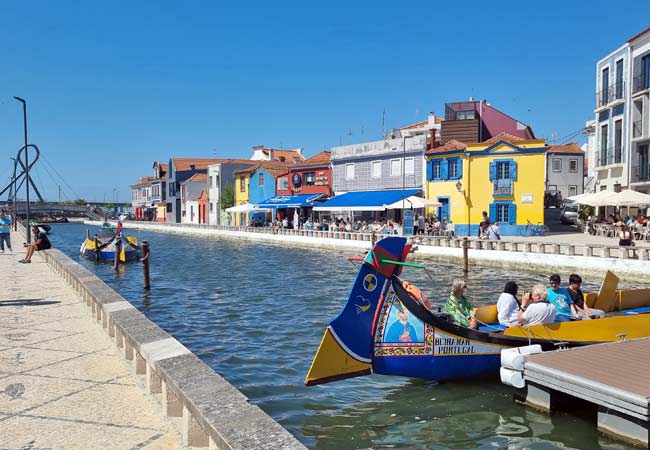
A boat tour on a Moliceiro boat will always be the highlight of Aveiro
Highlights of Aveiro
Below is an overview of Aveiro's top attractions and activities. Each of these will be explored in greater depth later in the guide.
1. Moliceiro boat tours: Colourful traditional boats offering canal cruises.
2. Art Nouveau Architecture: Ornate early 20th-century buildings featuring flowing lines and nature-inspired motifs.
3. Ponte Laços de Amizade: Bridge where visitors tie ribbons symbolising love and friendship.
4. Canal de São Roque: Quieter canal offering views of traditional houses and historic districts.
5. Museu de Aveiro: Former convent housing religious art and Saint Joana's tomb.
6. Igreja de São Domingos: Aveiro's cathedral, blending Gothic and Baroque styles.
7. Ovos Moles: Local sweet treat made from egg yolks and sugar.
8. Salinas de Aveiro: Ancient salt pans offering guided tours.
9. Old Railway Station: Displays impressive azulejo tile panels depicting local history.
10. Praça do Peixe: Traditional fish market square known for local seafood specialities.
11. Centro de Congressos de Aveiro: Former ceramics factory turned modern event venue.
12. Ponte dos Botirões: Innovative circular pedestrian bridge spanning two canals.
13. Igreja da Misericórdia: Mannerist church with blue azulejo-tiled façade.
14. The Forum: Modern shopping centre with distinctive architecture.
15. Costa Nova: Coastal village famed for its striped houses and beaches.
16. Museu Vista Alegre: Porcelain factory and museum south of Aveiro.
17. Igreja Válega: Known as “The most beautiful church in Portugal” with stunning tiled exterior
The interactive map below shows the location of these sights, and the blue lines mark the canals (Note: zoom out to see all of these points).
Legend 1) Canal Central 2) Canal das Pirâmides 3) Canal de São Roque 4) Museu de Arte Nova 5) Laços de Amizade Bridge 6) Museu de Aveiro 7) Igreja de São Domingos 8) Salinas de Aveiro 9) Old Railway Station 10) Praça do Peixe 11) Centro de Congressos de Aveiro 12) Ponte dos Botirões 13) Igreja da Misericórdia 14) Forum shopping centre
Sights near Aveiro: 15) Costa Nova 16) Museu Vista Alegre 17) Igreja Válega
Insight: The Canal das Pirâmides (pyramid canal) was named after the "pyramids of salt" that were piled up along its banks.
Aveiro is not Venice!
To fully appreciate Aveiro, avoid comparisons to Venice. While marketing may draw parallels, Aveiro's unique character extends far beyond its canals.
Approach Aveiro as a delightful Portuguese town with its own distinct charm. This perspective will ensure you make the most of your visit and appreciate all the city has to offer.
Detailed guide to the best sights and activities in Aveiro
Take a tour on a traditional Moliceiro boat
The delightful "Moliceiros" boats, similar in design to gondolas, are painted in bright colours and have motifs that depict scenes from the town's history. These boats, originally used to harvest seaweed, now serve a much more glamorous purpose in transporting tourists around the town's canals.
The beautiful boats are moored in the heart of Aveiro, along the central canal, and a short cruise allows tourists to glide past Aveiro's agricultural roots, historic buildings and modern developments.
It is highly recommended to take a cruise when first arriving to get a scenic introduction to the town or in early evening to get a picturesque vantage point as the sun sets over the town.
There are many small companies jostling for tourist trade along the Rossio and Fonte Nova Lagoon, but all of them take in the main sights. Moliceiro tours start at 10:00 and run until 18:30 (9:30 to 19:00 on weekends) and cost around €15 for a 45-minute boat ride.
The best spot to pick up a Moliceiro tour is from R. João Mendonça, which is next to Jardim do Rossio and directly in front of the Museu da Cidade de Aveiro. This area has plenty of charming cafés and restaurants nearby for tourists to visit while awaiting a cruise.
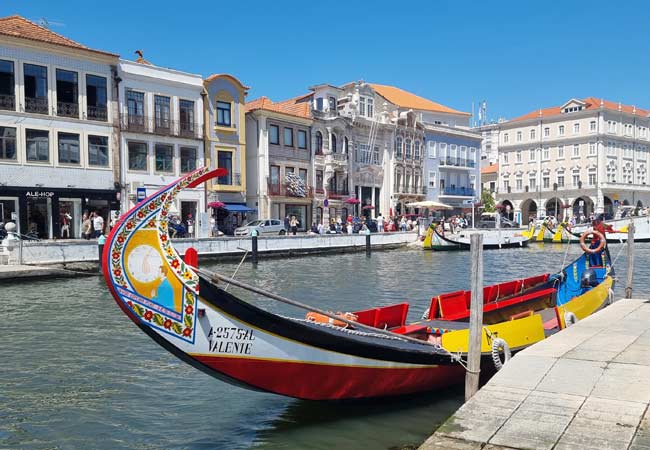
The colourful Moliceiros
Have you considered an organised tour to Aveiro?
An organised tour is a great way to discover Aveiro, especially if you are based in Porto. The standard of tours in Portugal is very high, with knowledgeable and enthusiastic guides, and tours that are designed for modern tourists. An organised tours provides the opportunity to fit so much sightseeing into a single day, while removing the hassle of public transport.
We have worked with GetYourGuide for the previous seven years, and some of their best tours of Aveiro include:
Art Nouveau Architecture in Aveiro
Aveiro's Art Nouveau architecture blossomed in the early 1900s, fuelled by the wealth of returning Portuguese emigrants from Brazil. This artistic movement, a response to industrialisation, found fertile ground in Aveiro's rich ceramic traditions.
The city's Fonte Nova factory, established in 1882, produced intricate tiles that became integral to these ornate designs. Today, Aveiro boasts numerous examples of this style, characterised by flowing lines and nature-inspired motifs adorning building façades. Notable Art Nouveau buildings in Aveiro include:
• Art Nouveau Museum (Casa do Major Pessoa, 1909): This exquisite building features intricate ironwork, beautiful tiles, and elegant curved forms.
• Casa da Cooperativa Agrícola de Aveiro (1913): The façade is entirely covered with hand-painted azulejos depicting lilies in pink and reddish hues.
• Ergovisão (Antiga Sapataria Miguéis, 1918): A former shoe store, now an Ergovisão shop, known for its distinctive window decorations and stylised floral motifs.
• Museu da Cidade (1915): Boasts magnificent stone arches and balconies, with a striking female figure head adorning the façade.
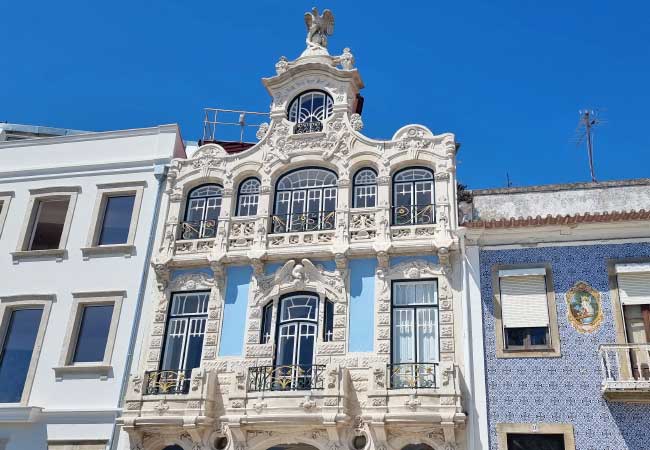
The Art Nouveau Museum
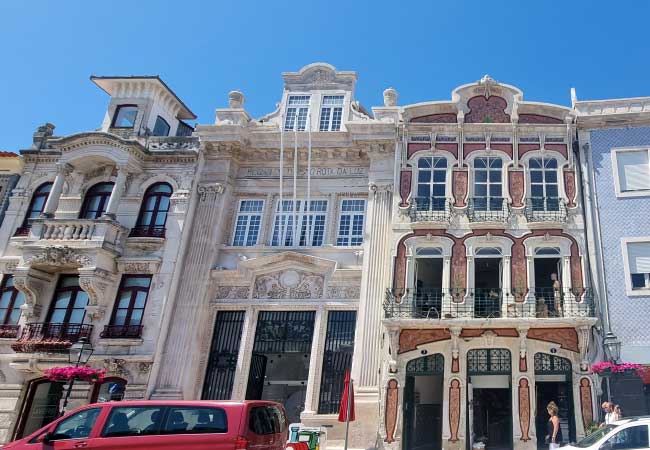
The Museu da Cidade (left) and the pink coloured Cooperativa Agrícola de Aveiro (right)
Tie a ribbon to the Ponte Laços de Amizade
A charming tradition has emerged at the Ponte Laços de Amizade (Friendship Ties Bridge) in Aveiro. Visitors tie colourful ribbons to the bridge's railings, symbolising love and friendship. This custom, started by university students in 2004, has transformed the bridge into a vibrant display of affection. You can purchase ribbons from nearby souvenir shops to add your own message.
The bridge, which spans the Cojo Canal near the Forum shopping centre, offers a picturesque spot for photos and a unique way to leave your mark on the city.
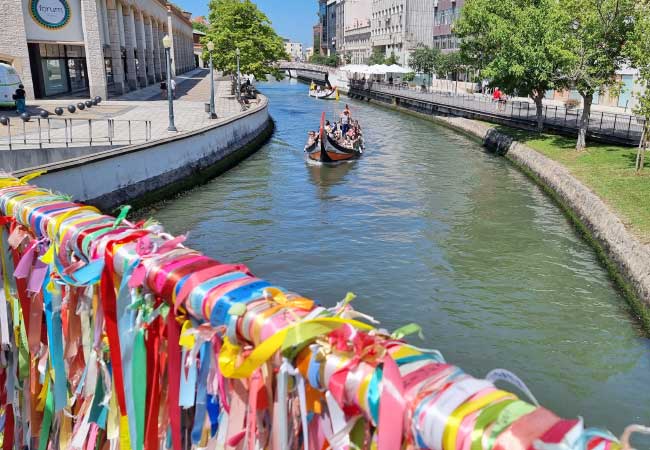
The Ponte Laços de Amizade bridge
Canal de São Roque
The Canal de São Roque offers a quieter, more authentic side of Aveiro away from the city center. This waterway skirts the historic Beira Mar fishing district, where traditional houses line the southern bank. In the past, wooden warehouses for storing salt dotted the canal's edge.
If you have extra time in Aveiro and want to explore beyond the main tourist areas, consider a 750-meter stroll along the canal from its eastern end to the Salpoente restaurant. Along the way, you'll come across the charming Ponte dos Carcavelos bridge, nicknamed the "Bridge of Couples in Love" - a picturesque spot for photos.
The scenic portion of the canal concludes near the Salpoente restaurant, which happens to be one of Aveiro's finest dining establishments.
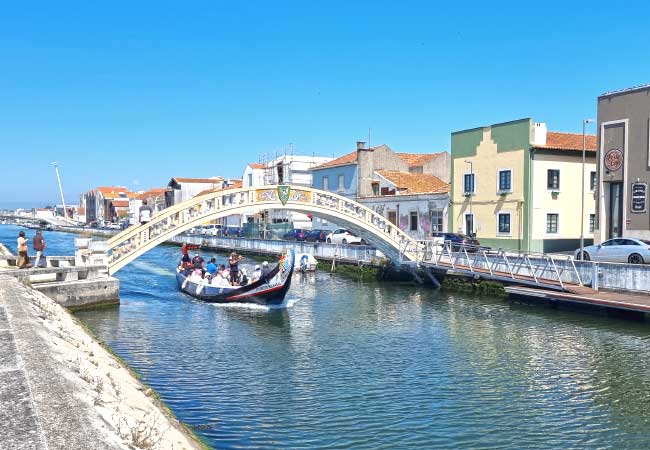
The Ponte dos Carcavelos bridge
Museu de Aveiro
The Aveiro Museum, housed in the former Convent of Jesus, offers visitors a captivating journey through Portugal's religious history and art. Originally founded in 1458, the convent gained prominence when Princess Joana, later beatified as Saint Joana, resided there in the 15th century.
The museum's highlights include Saint Joana's ornate marble tomb, lavishly decorated chapels adorned with azulejos tiles, and an extensive collection of religious art spanning paintings, ceramics, and jewellery.
The museum preserves several original convent spaces, including cloisters, the Chapel of St. Augustine, and parts of the refectory. The museum is open Tuesday to Sunday, 10:00-18:00 (closed 12:30-13:30 and Mondays), and admission is €4.
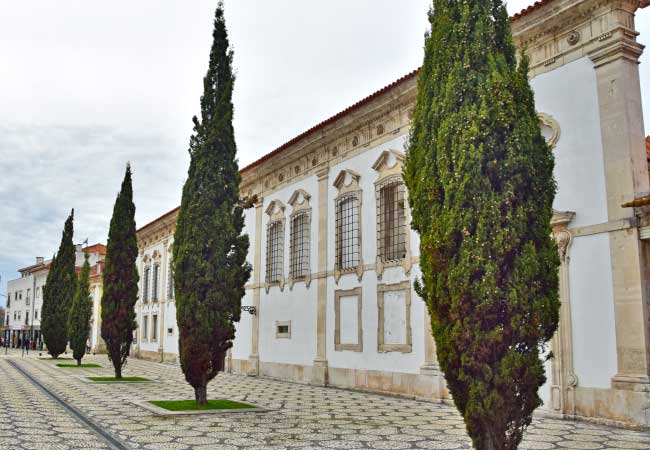
The museum was previously the Convento de Jesus
Sé Cathedral - Igreja de São Domingos
The Igreja de São Domingos, now Aveiro's cathedral, blends centuries of architectural styles within its white-washed walls. Originally founded as a Dominican convent in 1423, it evolved into the city's main cathedral over time.
The simplistic external limestone facade exhibits the original Gothic design but the rest of the church underwent significant baroque renovations in the 17th and 18th Centuries.
Inside, visitors can admire the beautiful Baroque portal, intricate side chapels featuring 16th-century artwork, and a Gothic alabaster Virgin and Child. The cathedral's rich history is evident in its Manueline stone cross and mix of Mannerist, Baroque, and Modernist elements. In 2013, a new organ from Hungary was installed in the transept, replacing the non-functional 18th-century original.
The Cathedral is situated next to the Aveiro Museum, along Rua Batalhao Cacadores and is open daily around mass times. Entry is free.
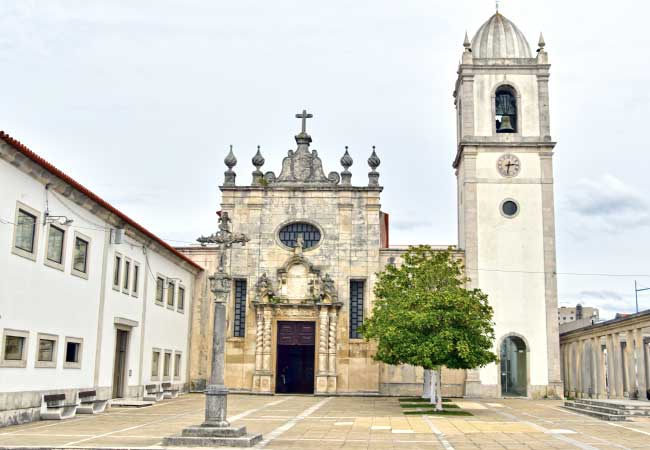
Sample Aveiro's delicious Ovos Moles
Ovos Moles, Aveiro's iconic sweet treat, originated in the city's convents centuries ago. These delicate confections consist of egg yolks and sugar encased in a thin wafer shell, often shaped like fish or barrels.
The recipe was allegedly created by nuns looking to use up excess egg yolks left over from starching their habits with egg whites. Today, Ovos Moles hold Protected Geographical Indication status from the EU, ensuring their authenticity. You'll find them in pastry shops throughout Aveiro.

Ovos Moles de Aveiro… Yummy!
Salinas de Aveiro (Aveiro salt pans)
The Salinas de Aveiro offer a fascinating glimpse into Portugal's salt-making heritage, with origins dating back to 929 AD. These rectangular tanks, where seawater evaporates naturally, are still worked by local 'marnotos' using age-old techniques. Beyond their historical significance, the salt pans form a unique ecological habitat, attracting diverse birdlife.
In the 1950s, the site covered over 2,600-hectares and boasted 256 individual salt pans but has since dwindled to just nine.
Visitors can take guided tours to learn about the traditional methods and cultural importance of this area on a 60-minute guided tour. Tickets cost €7 for adults and €3.50 for children, and for full details see the Salinas de Aveiro website: https://salinasaveiro.com/visits/
Azulejos tile paintings on Aveiro Railway Station
Aveiro's historic railway station boasts an impressive collection of azulejo tiles, installed in 1916 when the current building replaced its modest predecessor. Crafted by local artisans Francisco Pereira and Licínio Pinto, the 50 panels in blue, yellow, and white adorn the station's exterior, narrating Aveiro's rich history.
These intricate designs showcase regional landmarks, traditional occupations, and maritime scenes, including depictions of salt marshes and the iconic Barra Lighthouse. Curiously, the tiles' unveiling sparked considerable controversy, even leading to legal disputes.

Praça do Peixe (Fish Market Square)
Aveiro is renowned for its fish delicacies and the best place to sample the local cuisine is at the lively traditional Fish Market Square (Praça do Peixe). Amongst these, Eel based dishes are one of the most popular with locals. There are three main dishes; Eel stew, fried Eels and Eel with escabeche sauce. Other specialities include Cod and Lamprey.
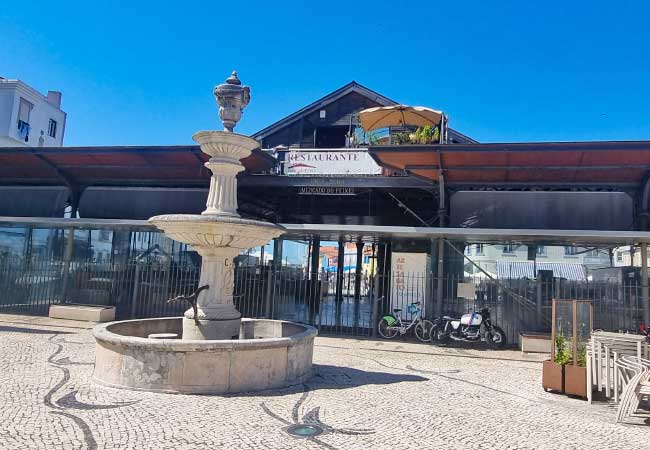
Centro de Congressos de Aveiro
The Centro de Congressos de Aveiro, a striking red-brick building on the Fonte Nova Lake, embodies Aveiro's industrial heritage reimagined for modern use. Originally a ceramics factory built in 1915, this architectural gem now hosts a variety of events in its two auditoriums, which can accommodate up to 1,000 participants daily. The centre offers state-of-the-art facilities for conferences and performances, along with a restaurant overlooking the Ria.
The Ponte dos Botirões
The Ponte dos Botirões bridge is a modern architectural marvel that spans the intersection of two canals with its unique circular design.
Opened in 2006, this pedestrian bridge has a 26-meter perimeter, suspended by cables from an inclined mast. Its distinctive "bow" shape mast has quickly become a city landmark.
The bridge's innovative design allows pedestrians and cyclists to cross two canals simultaneously, its transparent curved guardrails offer unobstructed views of Aveiro's picturesque waterways. The bridge spans the Canal de São Roque and the shorter Canal dos Botirões.
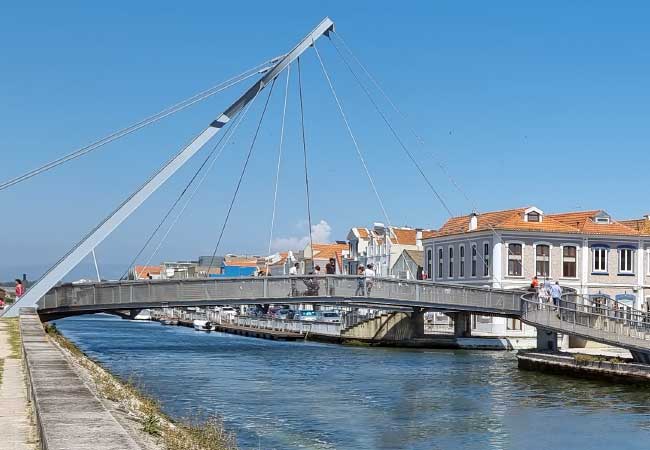
Igreja da Misericórdia
The Igreja da Misericórdia is a striking Mannerist church in Aveiro's heart that boasts a façade adorned with vibrant blue azulejo tiles. Completed in 1653, it features a grandiose classical limestone portal with Baroque embellishments. Inside, visitors can admire polychrome tile work, a Mannerist gilded altarpiece, and a barrel-vaulted ceiling.
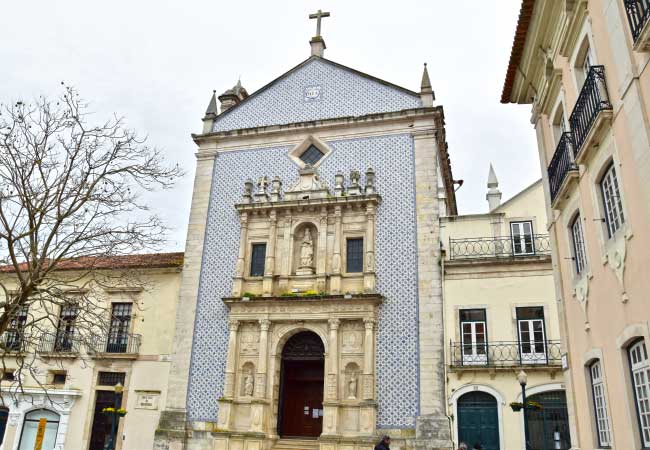
The Forum - shopping centre
This architecturally stunning contemporary shopping centre has won awards with its distinctive green spaces and stone facades, which are harmonious with the historic centre. The Forum has also been engineered to be sustainable and ecologically friendly and is a vibrant, fun epicentre where students, locals and visitors can shop, eat and be entertained.
The shopping centre is filled with 76 shops; including world renowned brands, a cinema, garden and a range of chain restaurants and cafes. Located along the Rua Batalhão Caçadores and central canal, the centre is open daily and is a shopper’s paradise.
Sights around Aveiro
Costa Nova
Costa Nova is a charming coastal village near Aveiro known for its distinctive striped houses. These colourful cottages, originally used by fishermen, now create a picturesque backdrop for photos. The village's long, sandy beach is popular for sunbathing and water sports, especially surfing and kitesurfing. Visitors come to enjoy the laid-back atmosphere, fresh seafood, and scenic walks along the coast.
Related articles: Guide to Costa Nova
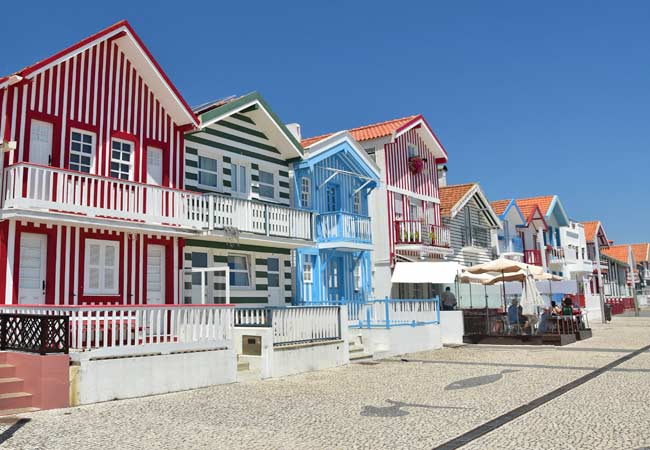
The colourful beach house of Costa Nova
Igreja Matriz de Santa María de Válega
The Igreja Matriz de Santa María de Válega is often called the most beautiful church in Portugal, thanks to its façade covered entirely in hand-painted tiles. This 18th-century church was rebuilt after a fire in 1787, but its colourful transformation didn't begin until 1958. The vibrant tilework that now adorns the exterior has earned it widespread acclaim.
Located 34 km north of Aveiro, the church makes for a worthwhile detour if you're driving back to Porto.

Museu Vista Alegre / Alegre porcelain factory
The Alegre Factory is a cornerstone of Portuguese porcelain production since 1824. Located about 10 km south of Aveiro, this factory complex offers visitors a fascinating glimpse into the world of fine porcelain production.
This sprawling complex invites you to explore its museum, chapel, and founder's restored manor. Watch skilled artisans craft delicate pieces and admire the site's Neo-Gothic chapel adorned with azulejo tiles.
The museum showcases two centuries of decorative arts evolution. For €6, you can immerse yourself in Portugal's ceramic heritage and even spot storks nesting atop the old factory chimneys. The on-site outlet offers discounted Vista Alegre products for those seeking authentic Portuguese craftsmanship.
If you've found our content valuable, we'd welcome your support.
The digital publishing landscape has evolved significantly. As a small independent publisher, we face growing challenges. Search engines increasingly favour paid content over organic results, while AI-generated content often reproduces original work without attribution.
To support our work, please consider bookmarking this page (press Ctrl + D) for quick access. If you find an article helpful, we'd be grateful if you'd share it with friends on social media.
For specific questions, please see our Reddit community at r/LisbonPortugalTravel.
Should you notice any outdated or incorrect information, please contact us at [email protected]
Thank you for helping us continue to provide valuable content in an increasingly challenging digital environment.























